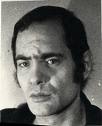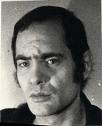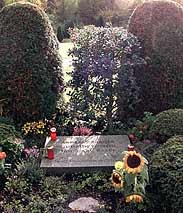Born in Munich, Baader was a high school dropout and criminal before his RAF involvement. He was one of the few members of the RAF movement who did not attend a university.
In 1968, Baader and his girlfriend Gudrun Ensslin were convicted of the arson bombing of a department store in Frankfurt am Main. After being sentenced in November 1969, Baader fled, but was caught in April 1970. A few weeks later, in May 1970, he was allowed to study at the library of a research institute outside the prison, without handcuffs. Journalist Ulrike Meinhof and two other women were allowed to join him, and aided in his escape by opening a door to admit a masked man who fired shots that wounded a 64-year-old librarian, hitting his liver. Baader, the three women and the masked man fled through a window, and the group soon became known as the Baader-Meinhof Gang.
Baader and others then spent some time in a Fatah military training camp in Jordan before being expelled due to differences in attitudes. Back in Germany, Baader robbed banks and bombed buildings from 1970 to 1972. On June 1, 1972, he and fellow RAF members Jan-Carl Raspe and Holger Meins were apprehended after a lengthy shootout in Frankfurt.
From 1975 to 1977, a long and expensive trial took place in a fortified building on the grounds of Stuttgart's Stammheim prison. According to reports from his jailers (including Horst Bubeck), the defendants, especially Baader, kept their cells as dirty and disgusting as possible in order to discourage searches for items that might be smuggled in; at this time lawyers and defendants were not separated by panes of glass during unsupervised meetings, as evidenced by photos taken by inmates.
Ulrike Meinhof was found dead in her cell at Stuttgart-Stammheim on 9 May 1976, hanging from the ceiling. Members of the Red Army Faction and others claimed that she was killed by the German authorities. The so-called second generation of the RAF committed several kidnappings and killings in a campaign in support of their comrades. Nonetheless, the three remaining defendants were convicted in April 1977 of several murders, attempted murders, and of forming a terrorist organization, and were sentenced to life imprisonment.
With the kidnapping of Hanns Martin Schleyer on 5 September 1977 and the hijacking of Lufthansa Flight 181 in mid-October, terrorists tried to force the release of Baader and ten other imprisoned RAF members. At the conclusion of a period of several weeks that came to be called the German Autumn, the passengers of the Boeing 737 named Landshut were freed in an assault carried out by German GSG 9 special forces in the early hours of 18 October 1977.
In Stammheim, Raspe learned of GSG 9's success on a smuggled transistor radio, and spent the next few hours talking to Baader, Ensslin, and Möller, who agreed to a suicide pact. In the morning, Andreas Baader and Jan-Carl Raspe were found dead in their cells, having died from self-inflicted gunshot wounds, while Gudrun Ensslin was found hanging from a noose made from speaker wire. RAF member Irmgard Möller was found with four stab wounds to her chest, but survived. Baader had fired two shots: one at the cell wall and one into a pillow, to give the impression of a fight, before killing himself.
All official inquiries on the matter concluded that Baader and his two accomplices committed collective suicide, and Baader-Meinhof biographer Stefan Aust argued in his book, The Baader-Meinhof Group (1985) that they almost assuredly did kill themselves, but it remains an article of faith among many people on the left that they were murdered, including Irmgard Möller who still insists that the deaths and her injury were extrajudicial executions.
Born in Munich, Baader was a high school dropout and criminal before his RAF involvement. He was one of the few members of the RAF movement who did not attend a university.
In 1968, Baader and his girlfriend Gudrun Ensslin were convicted of the arson bombing of a department store in Frankfurt am Main. After being sentenced in November 1969, Baader fled, but was caught in April 1970. A few weeks later, in May 1970, he was allowed to study at the library of a research institute outside the prison, without handcuffs. Journalist Ulrike Meinhof and two other women were allowed to join him, and aided in his escape by opening a door to admit a masked man who fired shots that wounded a 64-year-old librarian, hitting his liver. Baader, the three women and the masked man fled through a window, and the group soon became known as the Baader-Meinhof Gang.
Baader and others then spent some time in a Fatah military training camp in Jordan before being expelled due to differences in attitudes. Back in Germany, Baader robbed banks and bombed buildings from 1970 to 1972. On June 1, 1972, he and fellow RAF members Jan-Carl Raspe and Holger Meins were apprehended after a lengthy shootout in Frankfurt.
From 1975 to 1977, a long and expensive trial took place in a fortified building on the grounds of Stuttgart's Stammheim prison. According to reports from his jailers (including Horst Bubeck), the defendants, especially Baader, kept their cells as dirty and disgusting as possible in order to discourage searches for items that might be smuggled in; at this time lawyers and defendants were not separated by panes of glass during unsupervised meetings, as evidenced by photos taken by inmates.
Ulrike Meinhof was found dead in her cell at Stuttgart-Stammheim on 9 May 1976, hanging from the ceiling. Members of the Red Army Faction and others claimed that she was killed by the German authorities. The so-called second generation of the RAF committed several kidnappings and killings in a campaign in support of their comrades. Nonetheless, the three remaining defendants were convicted in April 1977 of several murders, attempted murders, and of forming a terrorist organization, and were sentenced to life imprisonment.
With the kidnapping of Hanns Martin Schleyer on 5 September 1977 and the hijacking of Lufthansa Flight 181 in mid-October, terrorists tried to force the release of Baader and ten other imprisoned RAF members. At the conclusion of a period of several weeks that came to be called the German Autumn, the passengers of the Boeing 737 named Landshut were freed in an assault carried out by German GSG 9 special forces in the early hours of 18 October 1977.
In Stammheim, Raspe learned of GSG 9's success on a smuggled transistor radio, and spent the next few hours talking to Baader, Ensslin, and Möller, who agreed to a suicide pact. In the morning, Andreas Baader and Jan-Carl Raspe were found dead in their cells, having died from self-inflicted gunshot wounds, while Gudrun Ensslin was found hanging from a noose made from speaker wire. RAF member Irmgard Möller was found with four stab wounds to her chest, but survived. Baader had fired two shots: one at the cell wall and one into a pillow, to give the impression of a fight, before killing himself.
All official inquiries on the matter concluded that Baader and his two accomplices committed collective suicide, and Baader-Meinhof biographer Stefan Aust argued in his book, The Baader-Meinhof Group (1985) that they almost assuredly did kill themselves, but it remains an article of faith among many people on the left that they were murdered, including Irmgard Möller who still insists that the deaths and her injury were extrajudicial executions.
Sponsored by Ancestry
Advertisement
Explore more
Sponsored by Ancestry
Advertisement





